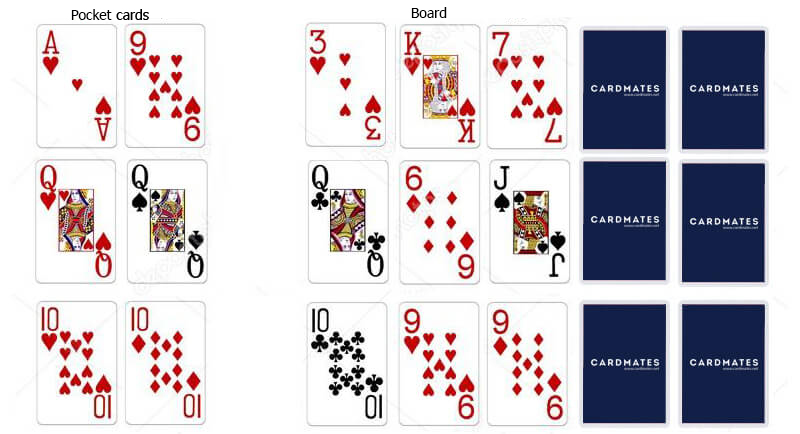Poker Terminology The Nuts
Nuts - The best possible holding given the situation.
When a player makes the best hand possible it is commonly referred to as “the nuts.” When a player makes the nuts, the term “nut” is often used as an adjective to describe the hand that was made. For example, if the unbeatable hand was a flush, that player would hold “the nut flush,” and if it were a straight, that player would hold “the nut straight.” In certain situations, a set can be the nuts.
Holding the nuts is an enviable spot to be in, but it is important to recognize that all nut hands are not created equal. If you make a nut hand that nobody else can even tie, you have “the exclusive nuts.” An example of this would be if you were playing Hold’em and held A♣ J♣, and the board read T♣ 4♣ 3♣ Q♦ K♦. In this situation, your ace high flush would be the exclusive nuts, because you cannot be beaten or even tied, given the board. In the alternative, it is also possible to make the nuts in a non exclusive fashion, depending upon the layout of the cards. For example, if the board read T ♥ 4♥ 3♣ Q♦ K♦, instead of T♣ 4♣ 3♣ Q♦ K♦, you would still have made the nuts with A♣ J♣, which completes an Ace high straight. You still have the nuts, but you do not have the exclusive nuts, because any other ace-jack can tie your hand, resulting in a chopped pot. This happens relatively infrequently in Hold’em games, and the non-exclusive nuts is still a monster hand that you can raise and reraise with.
This is not necessarily the case for all nut hands in all poker games. If you play hi/lo split games, like Omaha Eight or Better (O8), you will have to take a different approach to low nut hands than you do with high nut hands. One reason for this is that Omaha High/Low players must use exactly two of their hole cards when they form their hands, but they each hold four hole cards yielding six possible combinations. This often leads to multiple players making the same nut low during the same hand. Since Omaha High/Low is a split pot game, when this occurs, all eligible nut low hands must share the low side of the pot equally. This means that each player who holds the nut low could realistically get only 1/4th, 1/6th, or even 1/8th of the pot, depending upon how many other players are also holding the nut low. As the fraction of the pot you are entitled to shrinks, so does the return on the money you’ve invested into the pot. When multiple players make the same low, the return on investment (ROI) can frequently be negative. This means that you can end up putting in more in bets than you receive in winnings at the conclusion of the hand, and so you lose money. When you cannot win the high side of the pot, and you have to share the low side with another player, it is called “getting quartered.”
Because the risk of getting quartered is so high in Omaha High/Low, you need to be careful about how aggressively you bet nut low hands, especially if you do not have much of a chance to win the high side. Costing yourself bets by overbetting or raising a nut low hand when you are getting quartered is a frequent rookie mistake, and making it is almost guaranteed to annoy the other person who has made the nut low. In many situations, the nut low is often weak enough in Omaha High/Llow that you should opt to check and call rather than bet or raise. In Pot Limit Omaha Eight or Better (PLO8) the dry nut low is often so weak that it should be mucked outright when facing a strong bet.
Usage: Nut Full House, Nut Straight, Nut Flush, Nuts On The Flop, Nut high, Nut Low
Previous Poker Term: No-Limit
Examples: “That sushi spot is the nuts.” or “I’m the nut low at bowling.” What poker slang terms do you use in real life? Let me know in the comments below. If you ever need to reference any type of poker lingo, check out our extensive poker terms glossary. AdvancedPokerTraining.com, the world’s #1 poker training site, has developed the new “What’s the Nuts?” training game to help poker players improve their accuracy and speed in assessing the nuts. This fast paced and exciting game gives you a set of board cards, and asks you to select the 2 hole cards that would give you 'the nuts' in Texas Hold’em poker (an unbeatable hand).
When a player makes the best hand possible it is commonly referred to as “the nuts.” When a player makes the nuts, the term “nut” is often used as an adjective to describe the hand that was made. For example, if the unbeatable hand was a flush, that player would hold “the nut flush,” and if it were a straight, that player would hold “the nut straight.” In certain situations, a set can be the nuts.
Holding the nuts is an enviable spot to be in, but it is important to recognize that all nut hands are not created equal. If you make a nut hand that nobody else can even tie, you have “the exclusive nuts.” An example of this would be if you were playing Hold’em and held A♣ J♣, and the board read T♣ 4♣ 3♣ Q♦ K♦. In this situation, your ace high flush would be the exclusive nuts, because you cannot be beaten or even tied, given the board. In the alternative, it is also possible to make the nuts in a non exclusive fashion, depending upon the layout of the cards. For example, if the board read T ♥ 4♥ 3♣ Q♦ K♦, instead of T♣ 4♣ 3♣ Q♦ K♦, you would still have made the nuts with A♣ J♣, which completes an Ace high straight. You still have the nuts, but you do not have the exclusive nuts, because any other ace-jack can tie your hand, resulting in a chopped pot. This happens relatively infrequently in Hold’em games, and the non-exclusive nuts is still a monster hand that you can raise and reraise with.
This is not necessarily the case for all nut hands in all poker games. If you play hi/lo split games, like Omaha Eight or Better (O8), you will have to take a different approach to low nut hands than you do with high nut hands. One reason for this is that Omaha High/Low players must use exactly two of their hole cards when they form their hands, but they each hold four hole cards yielding six possible combinations. This often leads to multiple players making the same nut low during the same hand. Since Omaha High/Low is a split pot game, when this occurs, all eligible nut low hands must share the low side of the pot equally. This means that each player who holds the nut low could realistically get only 1/4th, 1/6th, or even 1/8th of the pot, depending upon how many other players are also holding the nut low. As the fraction of the pot you are entitled to shrinks, so does the return on the money you’ve invested into the pot. When multiple players make the same low, the return on investment (ROI) can frequently be negative. This means that you can end up putting in more in bets than you receive in winnings at the conclusion of the hand, and so you lose money. When you cannot win the high side of the pot, and you have to share the low side with another player, it is called “getting quartered.”

Because the risk of getting quartered is so high in Omaha High/Low, you need to be careful about how aggressively you bet nut low hands, especially if you do not have much of a chance to win the high side. Costing yourself bets by overbetting or raising a nut low hand when you are getting quartered is a frequent rookie mistake, and making it is almost guaranteed to annoy the other person who has made the nut low. In many situations, the nut low is often weak enough in Omaha High/Llow that you should opt to check and call rather than bet or raise. In Pot Limit Omaha Eight or Better (PLO8) the dry nut low is often so weak that it should be mucked outright when facing a strong bet.
Usage: Nut Full House, Nut Straight, Nut Flush, Nuts On The Flop, Nut high, Nut Low

Previous Poker Term: No-Limit
